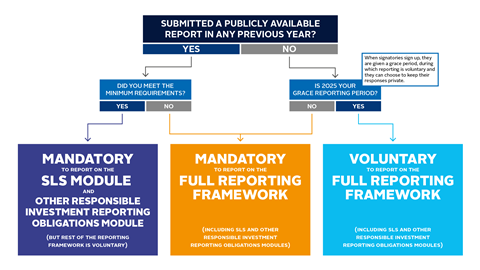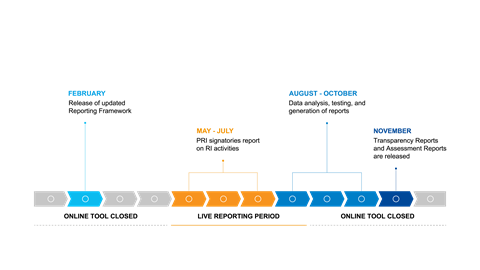Signatories commit to reporting on their responsible investment activities when signing the Principles. Investor signatories can report by responding to indicators in the Investor Reporting Framework, and submitting these in the Reporting Tool during the annual reporting cycle.
Who needs to report in 2025

As highlighted in the graphic above, all investment manager and asset owner signatories that have passed their grace period must complete the Senior Leadership Statement (SLS) and Other Responsible Investment Reporting Obligations (ORO) modules. These modules are easy to complete and provide a streamlined reporting option.
Signatories that have previously reported and met the minimum requirements can choose whether to complete the remaining modules in the Reporting Framework or submit a report with only the SLS and ORO modules.
For signatories in their grace period, reporting is completely voluntary, as it has been previously.
Investment managers and asset owners that have not reported publicly before, or that have not met the minimum requirements in the previous cycle, will be required to report in full.
Signatories completing only the SLS and ORO modules will receive a Transparency Report limited to these modules, while those completing all modules in the Reporting Framework will receive a comprehensive Transparency and Assessment Report.
The ORO module will allow signatories to disclose other responsible investment frameworks they report on. This data will inform the future development of PRI reporting within the Pathways model.
How to report
- Find out about the reporting process by reading our Reporting Framework and guidance for investors.
- Prepare for the reporting cycle by collecting your organisation’s answers to relevant indicators in the Reporting Framework.
- Access the Reporting Tool via the ‘PRI Applications’ tab on the top right-hand corner of https://www.unpri.org/.
All signatories are required to accept the PRI’s Terms and Conditions[2] in the Reporting Tool before starting their report. - Submit your report in the Reporting Tool by the reporting deadline.
Please refer to the Reporting Tool user guide for help using the Reporting Tool.
Why report
Reporting ensures:
- accountability of the PRI and its signatories;
- that signatories fulfil their commitment to the Principles;
- facilitates learning and development by providing an assessment of investment practices;
- gives signatories a tool to demonstrate leadership to key stakeholders;
- furthers the PRI’s data analysis, generating insights on responsible investment practices and trends to inform products, services and strategy.
New signatories do not have to report in their grace period, but we encourage them to do so, as they can learn from the process. New signatories that decide to report during their grace period can choose to keep their report private.[1]
Timeline for reporting

PRI signatories report annually using the Reporting Tool, which will only be open during the live reporting window.
Signatories can choose which 12-month period they report on. The reporting year may be the normal financial reporting year or a period that has been selected specifically for the purpose of reporting. We recommend that signatories keep the 12-month period they choose consistent across reporting cycles, to enable more accurate data analysis and comparison of scores across years.
After report submission
If you submit your report before the reporting cycle closes, you will receive the following:
- A public Transparency Report, which is published on the Data Portal, and includes all public and mandatory indicators.[1]
- A private Transparency Report, which is confidential and includes all public and private indicators.
- A private Assessment Report , which is confidential, and shows year-on-year progress and broad scoring bands per module or per asset class/sub-strategy as outlined in the Assessment methodology.
The PRI does not provide an overall organisation score.
If a signatory chooses to only complete the SLS and ORO modules, they will receive a Transparency Report consisting of responses from these modules only. If your organisation chooses to complete all modules within the full Reporting Framework, they will receive a full Transparency and Assessment Report.
Frequently asked questions
Will our report be assessed/scored by the PRI?
The PRI only assesses investors’ reports. Scores continue to be confidential and provided per module or per asset class/sub-strategy. The PRI does not provide an overall organisation score.
How long does it take to report?
This will vary based on the type of signatory (investment manager or asset owner) as well as the organisation’s size, structure and asset mix, which will determine which modules must be completed and what information flow and data tracking systems are in place.
How can I contact the PRI for reporting-based queries?
Send an email to [email protected].
Can I report in another language?
The official reporting language for the PRI is English. An English translation should be provided for any text entered in other languages.
What happens if my organisation is delisted?
Signatories required to report on a mandatory basis that do not submit their reported data by the deadline will be entered into the delisting process. We have previously included signatories delisted for failing to report in our Annual Report. A signatory can only relist after they have completed their reporting in the next available reporting window, and the grace year will not apply again.
If a signatory chooses to delist during the reporting cycle (including because they do not wish to complete the Reporting Framework), their account will be suspended when they have been delisted. Previously submitted reports that have been published will remain on the Data Portal (under the delisted category) but the organisation will cease to have access to this platform.
All submitted data will be retained in the PRI’s public and private databases. This is covered by the terms and conditions of the Reporting Tool. The PRI databases, including data from delisted signatories that submitted reported data, will be used to produce the aggregate statistics used in PRI data outputs such as snapshot reports and assessment analysis reports. Only active signatories will receive a copy of their Assessment Report.
Will signatories be delisted for failing to report in 2025?
Signatories that are not in their grace period and fail to report by the given deadline will be considered for delisting, as outlined in the Signatory rules.
For signatories in their grace period, reporting is completely voluntary, as it has been previously.
Which year’s data will signatories report on in 2025?
As in previous years, signatories will be able to specify the 12-month period they report on. The reporting year may be the normal financial reporting year or a period that has been selected specifically for the purpose of reporting in the PRI Reporting Framework. Most signatories report on the most recent 12-month period and would, therefore, in the 2025 reporting cycle, report on their practices during 2024.
We recommend that signatories keep the year-end date of the 12-month period they choose to report for PRI reporting consistent across years, to enable more accurate data analysis and comparison of scores across years.
Do larger signatories have an advantage over smaller ones when reporting? If so, then what apparatus is in place to mediate this?
Due to the nature of the PRI’s diverse signatory base, the Reporting Framework has been designed to capture responsible investment practices irrespective of an organisation’s size or level of experience. In addition, the PRI’s Assessment methodology does not promote any specific investment strategy or engagement method – its aim is to showcase best practices in responsible investment across asset classes worldwide.
Signatories have the option to filter for other signatories’ reports by size on the Public Reports page and can use the Customise Peer Function in the Data Portal to view signatories in their peer group and the practices they are engaged in.
How does the PRI verify the accuracy of submissions?
Because the PRI is not a regulatory body, we do not actively validate the accuracy of submitted data. However, we do take steps to reduce reporting errors and enhance the credibility of PRI data:
- Reports are made public.
- The Reporting Framework includes questions on confidence building measures a signatory has taken to ensure credibility of reported data
Signatories are also welcome to demonstrate or improve the credibility of the information they report through any of the following measures:
- Soliciting third-party independent assurance of selected processes and/or data related to their responsible investment processes, resulting in a formal assurance conclusion.
- Undergoing a third-party readiness review and making changes to internal controls/governance or processes in preparation for an external assurance review.
- Conducting an internal audit of selected responsible investment processes/and or data reported to the PRI.
Can I access the Reporting Framework from previous years?
The Reporting Frameworks from previous years are available to download from our Reporting & assessment archive.
What is the ORO module?
The ORO module allows signatories to disclose other responsible investment frameworks and regulations they report against, offering an opportunity to outline the extent of their reporting obligations. It consists of two indicators and the format is straightforward, featuring tick boxes and short-answer fields.
These indicators:
- give signatories an opportunity to share the extent of their reporting on responsible investment practices;
- provide the PRI with a better understanding of current and future reporting demands on signatories;
- collect data on international and regional reporting obligations to help the PRI develop guide the future development of PRI reporting within the Pathways model.
Is the ORO module assessed?
No, the ORO module is not assessed. However, the responses provided will be visible in signatories’ public Transparency Reports.
Is the ORO module mandatory?
There are two mandatory modules for signatories that are not in their grace period in 2025, the ORO module and the Senior Leadership Statement (SLS) module. Both are straightforward to complete, neither are scored. The rest of the Reporting Framework will be voluntary for most signatories.
Will there be any changes to the reporting outputs (public and private Transparency Reports and Assessment Reports)?
The PRI will continue to provide signatories with reporting outputs, including private and public Transparency Reports and Assessment Reports, as these are the main tools they use for learning and internal communication, as well as benchmarking progress. Assessment Reports will continue to be completely confidential and shareable at the signatory’s discretion. Only signatories that report in 2025 will receive reporting outputs for this year.
What outputs will signatories receive if they report in 2025?
Signatories that report in 2025 will receive Transparency and Assessment Reports, in line with our normal reporting processes. If they submit the same information as they did in 2024 (i.e. they confirm the pre-filled answers to each indicator without making any changes) then their 2025 outputs will reflect that. If signatories eligible for voluntary reporting choose not to report, they will not receive any outputs for this reporting year.
If a signatory chooses to only complete the SLS and ORO modules, they will receive a Transparency Report consisting of responses from these modules only. If your organisation chooses to complete all modules within the full Reporting Framework, they will receive a full Transparency and Assessment Report.
Can signatories select their own peering groups?
Yes, signatories can select their own peering groups. This functionality is available in the Data Portal. Please see our Data Portal user guide.
I am new to reporting. How do I access the Reporting Tool?
Fill in the Registration form and tick the ‘Request access to Reporting Tool’ box. You will receive an activation link within one hour.
The Admin user(s) of your organisation will need to invite you to access the Reporting Tool. For more information, see our Permissions System user guide.
Please note that the Reporting Tool will only be open during the live reporting window.
I forgot my password for the Reporting Tool. How do I get a new one?
Enter your email address on the Forgotten password screen to reset your password.
Will I be required to re-register to use the new Reporting Tool?
To avoid disruption, users of the reporting platform should check that they have access before the start of the reporting cycle. Each signatory’s Admin user(s) will have access to the Permissions System, where they can approve, deny or revoke a user’s access. Any new users will be invited by their Admin user(s) before they can access the Reporting Tool. Read our Permissions system user guide for more information.
How does pre-filling work?
If your organisation started or submitted a report in 2023 or 2024, you will automatically see your previous responses pre-filled in the Reporting Tool and highlighted by an amber box. If these responses are still accurate, you do not need to change them. However, you will still need to click ‘Save’ or ‘Save and continue’ before navigating between indicators, to ensure that the status of the module shows as ‘In progress’.
If a pre-filled response is no longer accurate, it can be amended. You must click ‘Save’ or ‘Save and continue’ to ensure any changes are recorded. If you do not save the changes you make, they will be lost, the response will revert to the original pre-filled answer and the status of the module will continue to show as ‘Not Started’ on the overview page.
We strongly encourage signatories to review all answers before submitting their reports, as changes cannot be made once the reporting window closes.
My organisation started completing a report last year but did not submit it. Will our answers be pre-filled?
Yes, any answers that were saved in the Reporting Tool in 2023 or 2024 will automatically appear this year and will be highlighted by an amber box. As highlighted above, you will need to review and/or update these pre-filled responses and click ‘Save’ or ‘Save and continue’, to ensure that any changes are recorded and that the module status reflects your progress, before navigating between indicators.
How many indicators will be pre-filled in the Reporting Tool?
Automated pre-filling will be in place for all signatories that reported in 2023 or 2024, automatically populating 95% of indicators. Indicators that are not pre-filled either relate to an answer specific to the current reporting year or have been updated or amended to fix errors identified during the 2024 reporting cycle or to improve logic and clarity. Signatories can use their 2023 or 2024 Transparency Reports and the Indicator changes guide to identify where they might need to amend their pre-filled answers or where indicators will not be pre-filled.
Can I download my reporting survey responses as I complete them?
Yes, you can download your reporting survey responses as you complete them. Once you have logged into the Reporting Tool and have accepted the Terms and Conditions, the Organisational Overview and Senior Leadership Statement modules will be available to answer and you will be able to download your pre-filled or new responses. The download will only include your responses to unlocked indicators. Once you start unlocking the other modules relevant to your organisation, you will be able to download your pre-filled or new responses to these as well, by using the “Click to download a DOCX version of this indicator” button at the top of the Overview page.
How does the PRI develop Reporting Framework modules?
The PRI regularly updates the Reporting Framework to ensure that it reflects best practice and allows signatories to report on their RI activities. Occasionally, modules in the Reporting Framework need to be changed more extensively to reflect updates in the investment industry. Changes to the PRI Reporting Framework will be made for the following reasons:
- To clarify points of confusion or provide improved guidance to signatories;
- To support a more robust assessment methodology;
- To facilitate better analysis of the data;
- To strengthen accountability;
- To respond to input from the PRI Board.
How was the PRI Reporting Framework developed?
PRI reporting was introduced in 2006 under a self-assessment model, and following extensive signatory consultation, the reporting and assessment process was developed to ensure signatory responses were more robust.
A pilot version of the Reporting Framework was launched for testing in June 2012 – with signatories reporting on ESG incorporation for the first time. In 2021, we asked signatories to report on the depth of ESG incorporation and on sustainability outcomes for the first time.
Looking forward, we recognise that our approach to reporting needs to evolve further, to ensure that the PRI can maintain its signatory-centric approach while adapting to broader industry shifts. The investment reporting landscape has changed significantly in recent years, as have our signatories’ needs and challenges.
Why do we have to disclose our AUM?
The PRI requires signatories to provide an AUM figure upon joining and then every year they complete the Reporting Framework. We use this information in several ways:
- To assign the correct fee band to signatories
- To calculate the overall PRI signatory AUM
- To create peer groups for signatory assessment
- For signatory segmentation activities, including calculating the size of asset class allocations
Can we prevent our AUM and/or other indicators from being disclosed in our Transparency Reports?
Signatories that are unable to comply with disclosure requirements may submit a formal request to the PRI for non-disclosure of certain indicators in their Transparency Report. We do not expect these requests to be necessary except in rare situations, and you should speak to your Responsible Investment Manager before submitting a non-disclosure request to discuss all options.
What are the grounds for submitting a non-disclosure request?
As a guideline, signatories may submit a request to the PRI where disclosing their organisation’s response to a particular indicator would:
- conflict with local legislations or regulations; or
- conflict with an existing company policy (for example, a non-disclosure policy that is not specific to ESG issues). Requests of this type will be considered but are less likely to succeed where the policy jeopardises a signatory’s ability to fulfil Principle 6: ”We will each report on our activities and progress towards implementing the Principles.”
The PRI will also consider requests where signatories cannot be transparent about their AUM figure for confidentiality reasons.
Signatories may not submit a request for non-disclosure on the following grounds:
- General non-disclosure policies relating to ESG information. Reporting and disclosing responsible investment activities is a requirement of being a PRI signatory.
- Disagreement about the form or structure of a particular indicator. In these cases, signatories should provide feedback to PRI.
How and when can I submit a non-disclosure request?
In 2025, the PRI will consider two types of non-disclosure request:
- Request to not disclose responses to indicator OO4 (organisation AUM) only.
- Request to not disclose responses to all indicators, except for those in the SLS and ORO modules. This includes responses to indicator OO4.
Signatories may submit a non-disclosure request by sending a letter on their company letterhead to [email protected], detailing the type of non-disclosure request and the reasons for the request.
The deadline for submitting a non-disclosure request this year is 23 July.
Signatories wishing to appeal should continue to complete their reporting, without submitting their responses until a decision is made.
The PRI will contact signatories directly to inform them of the decision about their request. If granted, the Transparency Report will not contain the information that has been requested.
Can I request changes to my reporting after the submission deadline?
Once the reporting cycle has ended, the PRI is unable to accept changes to your report, including updates to Transparency and Assessment Reports or any additional text. We kindly ask that all signatories ensure their data is accurate before submission, as we rely on this to maintain the integrity of the reporting process.
What should my organisation do if it made a mistake when reporting?
If you find a mistake in your report after submission, unfortunately, the PRI won’t be able to make changes or issue a correction letter. As outlined in our Terms and Conditions, it’s the signatory’s responsibility to ensure the accuracy of the information before submission. We recommend double-checking your data carefully before submitting to help avoid any mistakes.
What if I missed the reporting deadline?
If you missed the reporting deadline or were unable to submit your report on time, we regret that we won’t be able to accept late submissions or make changes to your report. We encourage all signatories to keep track of the reporting deadlines and submit their reports as early as possible to ensure everything is in order before the cycle closes.
Are service providers required to report?
No, service providers do not report and have not since 2021.
The service provider Reporting Frameworks from previous years are available to download from our Reporting & assessment archive.
In the absence of reporting in 2025, how will service providers benefit from being signatories of the PRI?
Being a signatory of the PRI is a public demonstration of organisational commitment to incorporating ESG factors into investment decision-making and ownership practices. As part of our global, collaborative network, signatories have exclusive access to many resources, including the Data Portal, the Collaboration Platform, webinars, and topical reports, among others.
The PRI also has an archive list of all service provider signatories and the professional services they offer in a public directory for investors to utilise. This directory will be updated in 2025.
Downloads
Terms and Conditions – PRI Signatories
PDF, Size 0.21 mb
The reporting process
- 1
 Currently reading
Currently readingThe reporting process
- 2
- 3
- 4
- 5
- 6
- 7
- 8










